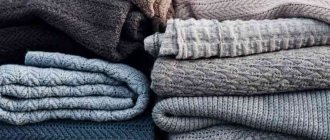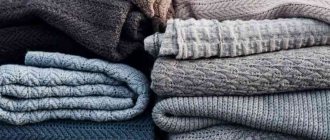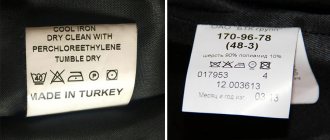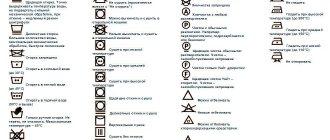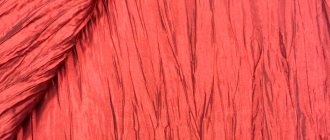Organza curtains are so popular today that they are found in almost every family. And this is no coincidence: the fabric is produced in a huge assortment. It comes in different colors, with patterns, etching, perforation, embroidery... Organza looks very attractive, and is quite affordable in price. This material does not require frequent washing, but you cannot do without it at all. How should you wash organza curtains to extend their service life? There are many nuances here, but compliance with them guarantees an excellent result.
Machine washable
Hand washing is ideal for organza tulle. But if you know how to wash it correctly in an automatic machine, you will significantly save your time. To ensure a successful wash, follow these simple rules:
- Remove the tulle from the curtain rod. Gently shake off the dust; it is better to do this outside or on the balcony.
- Soak the fabric, this step is important even when washing in a machine. Place the tulle in a bathtub or basin with lukewarm water to wash away most of the dirt and dust. Drain the water and lightly wring out the fabric.
- To prevent tulle from fraying, place it in a special mesh bag for washing delicate and thin items. If there is no bag, use a regular pillowcase. Place the product in the drum of the machine.
- Set the temperature to 30 °C, select the “delicate wash” mode. Turn off spin. The fabric is thin, so at high speeds its structure may change. Another important point: the higher the washing temperature, the more wrinkled the washed fabric will be.
- Pour a small amount of washing powder into the container. When washing organza, use liquid detergents. There is no need to add conditioner; this will cause the fabric to turn yellow when exposed to sunlight. If tulle needs to be bleached, use oxygen bleach. Do not use products containing chlorine.
- To thoroughly rinse the tulle, select the “extra rinse” mode. This will remove any remaining powder and help avoid streaks.
After washing, let the product hang over the bathtub or on the balcony to drain the water. Then hang the tulle in place. If creases are visible, iron the product. Set the temperature to the minimum; the “synthetic” or “silk” mode is ideal for ironing.
Washing in a washing machine
Having decided to wash soiled organza curtains in an automatic machine, you should adhere to the following algorithm:
- Dissolve 2 tbsp. l. detergent composition in 20 liters of warm water.
- Immerse the product completely in this solution and leave for an hour and a half.
- Rinse the fabric and place it in a special bag intended for washing. You can make it yourself using gauze.
- Place the prepared tulle in the drum.
ARTICLE FOR YOU
How to wash clothes and bed linen made of Tencel: in a washing machine and by hand
Washing in a washing machine
Select delicate mode with a maximum temperature of 30˚C. If possible, turn off the spin or set it to minimum speed. Program an additional rinse.
How to wash without shrinking clothes
Before preparing organza products for washing, you need to study the composition. Fabrics with a high percentage of natural fibers are subject to shrinkage. They cost more and look richer. Silk enhances the decorative effect and gives a pronounced shine.
To prevent shrinkage, only neutral products should be used for products made from such fabric. Organza, on which decorative elements embroidered with natural threads are placed, requires the same careful treatment.
When washing by hand, baby soap without dyes is used effectively. It is rubbed and dissolved in heated water (up to 40˚C) completely without any residue. If colored items are to be cleaned, then reduce the heat and make the solution no higher than 30˚C.
How to wash curtains without shrinking
Strong friction is not allowed during the washing process. Things are carefully lifted and lowered, slightly squeezing with light movements. The final step is to rinse first in warm, then cold water with the addition of vinegar. It is calculated that 1 tbsp is required per 1 liter. l. facilities. Things don't wring out.
How to wash so that the fabric shrinks
Sometimes you need to wash a holiday outfit that has stretched a little. The product will be able to shrink if natural silk threads predominate in the organza composition.
It is recommended to soak it in cold water for an hour. To remove excess moisture, wrap it in a large terry towel, trying to avoid the appearance of creases and folds.
You can slightly reduce the size of items made from thick organza made from polyester. For this purpose, they are washed in a machine on a cycle oriented for cotton textiles.
There is some risk of fabric deformation since the temperature is set at 60˚C. Therefore, it is advisable to have expensive products altered by sending them to a specialized studio.
How to wash organza so that it shrinks
Using the washing machine
Modern automatic machines have a delicate wash mode. To wash organza in an automatic washing machine, you need to use a mild detergent without using a spin cycle, but first shake out the accumulated dust and soak in a soap solution.
Instructions:
- The fabric is placed in a delicates bag and placed in the drum.
- The temperature is set at 30 degrees, the spin is turned off. If it is not provided for in the car, then it is set to the minimum speed.
- An additional rinse mode is necessary to remove soap deposits on fabrics.
- It is advisable to fill the compartment with a special liquid product intended for washing organza.
- Conditioner is not used, as fabric soaked in it turns yellow in the sun.
- Oxygen-containing bleach helps remove stains.
Modern organza tulle can be immediately hung on the window after washing. All irregularities on it are straightened out under the influence of gravity.
Read about how to iron tulle in this article. Read about how to iron tulle in this article.
Features of machine washable organza
Organza can only be washed with an automatic machine. Modern washing machines are equipped with new technologies and various washing modes, so you don’t have to worry about the safety of the fabric.
How to wash organza?
- Any washing powder is not suitable for washing this material. You need to use the one that produces less foam. It is best to use detergent for delicate items or liquid powder.
- It is not recommended to use chemical bleaches, especially those containing chlorine.
- It is also undesirable to use fabric softener. This may cause the fabric to turn yellow later.
Preparing for washing:
- First of all, the curtains must be carefully removed from the curtain rod.
- Shake them thoroughly to remove accumulated dust. It is advisable to do this outdoors or on the balcony.
- Even if you wash with an automatic machine, you need to soak them in clean cool water or in water with dissolved washing powder before washing.
Washing machine
How to wash organza curtains in a washing machine? To ensure a successful washing process, follow these recommendations:
- It is advisable to wash organza curtains inside a special laundry bag. You can purchase it at a hardware store or sew it yourself from gauze. Place the curtains inside the bag and place them in the drum.
- Set to delicate mode.
- The temperature should not be higher than 30 degrees, as tulle does not tolerate high temperatures.
- It is advisable to turn off the spin completely. If this is not possible, then you need to set the minimum speed.
- Set the extra rinse mode.
- After washing, you need to let the curtains drain.
- Hang them on a curtain rod while wet, and they will straighten out under their own weight, eliminating the need for ironing. If creases remain, use our selection of methods to straighten curtains while hanging.
Important! Sometimes you want to make some changes to the interior without special expenses or major renovations. This is entirely possible if you simply change the design of the windows. We offer some interesting ideas to help you:
- How to dye tulle?
- How to hang tulle beautifully?
- DIY curtain tiebacks.
General washing rules
When working with thin fabric, you need to pay attention to the general washing rules. Is it possible to place organza in the drum of a washing machine and how not to damage it during intensive care.
- The water should be no higher than 35 degrees. Boiling water leaves dents and folds that are difficult to smooth out, even with steam.
- Detergents should only be gentle. Aggressive powders can damage fabric fibers.
- To carefully wash organza, you need to use a special bag. In it, it will not lose its shine and will not acquire a matte shade.
- Organza curtains can be machine washed, but only on a delicate cycle. It is better to use high-quality gels as a detergent.
- You can wash organza curtains by hand, but you should not rub or twist them. Such handling results in damage to the fibers. The fabric should only be slightly squeezed to remove any remaining moisture, or allowed to drain.
Expert opinion
Kristina Samokhina, experienced housewife.
Thin curtains can be hung in a damp state if they are not very wrinkled. It is advisable to use a steamer for ironing. It will prevent damage to the fibers, and the fabric will remain shiny.
How to wash organza in a machine? (+video)
Organza tolerates machine washing quite well. But only if all the rules and recommendations are followed:
- to ensure safety, place the item in the washing machine in its packaged form (you can use special laundry bags or, if you don’t have them, a pillowcase);
- use the “hand” or “delicate” washing modes (if the machine is old and does not have such options, use its most gentle operating mode);
- the water temperature should be no more than 40 degrees;
- Machine spinning can theoretically be done, but it is better to refrain - organza is very sensitive to such effects.
How to wash organza without ironing
The most important thing is not to wring out the fabric, so as not to iron it later to remove any creases that have formed. Dry flat. After the water has drained, the organza tulle, wet, is hung in a permanent place on the cornice. There it dries and takes its original form. If after drying the curtain is not smooth enough, you can eliminate the roughness directly by hanging it on the window using a steam generator at low temperature.
Watch the video - how you can wash organza so that it doesn’t wrinkle.
How to iron organza correctly
Ironing is performed at the minimum heating temperature of the iron and only from the wrong side. In this case, the material must be wet. After washing, when the water has drained, place the item on a thick fabric, such as a towel. Cover the top of the product with gauze, tissue paper, cotton or other thin fabric. Then iron the reverse side with a warm iron.
Press the iron firmly onto the fabric, but do not hold it in one area for too long. Iron each place several times. During the process, do not use hot steam, otherwise the organza will ripple. Wide curtains can be folded in several layers. Move the long tulle gradually behind the back of the ironing board, stroking section by section. How to properly iron curtains, see the link.
Do I need to starch organza?
Impregnation of the material with a special composition, as a result of which the rigidity of the fabric increases, is called the starching process. This method not only increases the density of the product, but also increases wear resistance and resistance to stains. Usually, a specially prepared starch-based solution is used for this purpose, although there are ready-made household chemicals that simply need to be diluted according to the instructions. Whether to starch tulle curtains or not is up to each housewife to decide on her own, since with increasing rigidity the process of giving shape becomes more complicated, and the decorative effect of the tulle also decreases.
How to quickly starch organza:
- Rinsing curtains in a cold saline solution increases density without weighing down the fabric.
- The use of starch is undesirable due to the possible appearance of yellowness on the curtains.
- Ready-made products should be intended for delicate fabrics and should be used in clearly specified proportions.
Wash by hand
Hand washing for organza is considered the most gentle procedure, as it avoids damage to the fabric.
Rules for washing organza products by hand
It is carried out in the following sequence:
- Pour warm water into the container at a temperature of no higher than 40 degrees.
- Add a neutral detergent, calculating that 1/2 tbsp is required. l. for 5 liters of water.
- Immerse the product completely in the solution and leave for 2 hours.
- Gently wash the fabric, lifting and lowering, without rubbing or twisting, using light squeezing movements.
Rinsing is carried out first in slightly warmed and then cool water. The movements are carried out without pressing. Lift the fabric and immediately place it on the rope to drain excess moisture.
The process of washing organza curtains
If the curtains were purchased ready-made, you need to study the care instructions. As a rule, this fabric can be washed by hand and in an automatic machine with equal success.
Basic rules for washing organza products:
- completely dissolve the detergent at a temperature of approximately 40 °C;
- put the fabric in water for one hour;
- wash the product without stretching and avoiding aggressive spinning, otherwise the fragile structure of the fabric may be damaged;
- rinse the curtain in cool water at least twice, especially when using powder, so that no soapy streaks remain;
- gently squeeze or do without squeezing at all;
- hang the curtain to let the water drain out;
- hang the product to dry.
Hand wash curtains
Hand washing is the best solution for light and delicate fabrics. It includes several stages and involves certain nuances. So, how to properly wash tulle by hand?
To begin, remove the tulle from the window and shake it to remove any settled dust. After this, you must first soak the curtain in warm water. This step is aimed at preparing the fabric for washing and making it easier to remove yellowing and stains that often appear on light-colored materials.
For soaking, you can use either your regular laundry detergent or table salt. It perfectly softens water and helps remove many serious contaminants. The soaking process lasts from 1.5 to 2 hours. Then you need to remove and rinse the tulle thoroughly in running water. Never use hot water on such fabrics: they will become hard and turn yellow quickly.
Next, you have to wash the tulle. Actually, washing consists of 2 stages.
First stage
Place in tulle in a bath or large vat of warm water. At what degrees should you wash? The optimal temperature is 30-35 degrees. In order to effectively wash a yellowed curtain, add apple cider vinegar at the rate of 1 tbsp. l. for 1 liter of water.
Now you need to choose your powder. The best option would be a gel for washing delicate fabrics. If you do not have a special product, use powder for automatic washing machines. The fact is that ordinary powder produces a lot of foam, which is difficult to get rid of during rinsing. And machine wash products practically do not form it.
After all the preparations, you should immediately start washing.
Choose a product that produces minimal foam.
Second phase
For the second stage, change the water and add a few drops of blue to it. The resulting solution should have a slight bluish tint. Dip the tulle into it and wash it again. Almost done! All that remains is to rinse the material in cool water, hang it up to drain and dry, and iron it thoroughly. The last point can be abandoned in the case of organza tulle. In this case, simply hang slightly damp curtains on the curtain rod. They will dry and smooth out on their own.
How to wash tulle
Although curtains are not something that easily gets dirty stains, dust accumulates on them day after day, so washing them periodically is simply necessary.
You need to wash tulle made from any material once every two to three months, but not less often, because all textile interior items accumulate dust, breathing which is harmful to health. And especially tulle and curtains, because, unlike carpets and upholstery, they cannot be vacuumed during cleaning.
Organza, when it comes to washing, requires a special approach, because this fabric is from the “capricious” category. Therefore, let's learn how to properly wash organza curtains so that after “water procedures” you don’t have to buy new products.
Machine washable
Despite the fact that in the minds of many housewives, delicate fabrics and machine washing are incompatible concepts, modern household appliances are designed for a variety of purposes. And you can wash organza in a machine.
It is only important to comply with a number of conditions :
- Remove the curtain from the curtain rod and shake it several times in the fresh air to partially remove dust. Carefully roll up and place in a special laundry bag. If you don't have one, a regular pillowcase will do.
- Place the tulle package into the machine drum. In this case, it is better to put only it, not to wash other things along with the tulle. Turn on the delicate or hand wash cycle. Usually the machine automatically sets the temperature to 30 degrees. If not, install it manually.
- Do not use the wringer on organza curtains. Because of this, the fabric may become deformed. As a last resort, turn on the spin cycle at minimum speed.
- After washing, remove the tulle from the bag and immediately hang it on the curtain rod. You can also hang it on the balcony or in the yard, but in this case, after drying, a fold will go through the entire curtain in the place where it bent over the clothesline.
A very important point in any washing method is the choice of detergent. Powders with minimal foaming are best suited for organza, otherwise soapy streaks will remain on the tulle after drying.
The ideal option is liquid powders designed for washing delicate fabrics.
When washing organza, you need to put any detergent into the machine in small quantities so that it is washed out of the tulle without any residue. If you still go too far, turn on the machine for an additional rinse.
Important: if you need to bleach an organza curtain, never do it with products containing chlorine. Use oxygen bleaches.
Handwash
It would seem that there is nothing easier than washing a curtain by hand: you can control the water temperature, the intensity of washing, rinsing, spinning, etc. with your own hands. But in the case of organza, some rules should be followed.
Hand washing takes place in several stages :
- Fill the bathtub with warm water and add 2-3 cups of salt, which will help soften it, and a cup of laundry detergent.
- Soak the tulle in the resulting solution, wrinkling it a little with your hands until it is completely wet and in the water. And leave it like that for 3 hours.
- After this, proceed directly to washing. It represents a collapse of the material across its entire width. Do not rub or twist the fabric under any circumstances.
- When you have gone through the entire curtain with creasing movements, drain the water from the bath and fill it again with cool water. And so on several times until you have washed all the powder from the tulle.
After hand washing, just like after machine washing, you can immediately hang the curtains on the curtain rod.
Tip: If you are washing a curtain that has been hanging in the kitchen and has absorbed grease and grime, add a little dishwashing detergent to the water when soaking.
Also, while in the kitchen, an organza curtain can become dirty not just with dust or fumes, but with stains that will have to be removed separately. Immediately discard all store-bought stain removers: they are very aggressive towards sensitive material.
You can use a simple home remedy that is easy to prepare yourself. Take 80 ml of vinegar 9%, 20 g of salt and a few drops of ammonia. Mix, apply to stain before soaking and leave for 10 minutes.
Subtleties of washing fine fabrics
The first thing you need to firmly understand is that you cannot put organza in the drum of a washing machine or in the bathtub for hand washing as soon as you remove the textiles from the window. Because dust particles accumulated on the surface of the fabric during washing, even in warm water, will become firmly embedded between the fibers. And then she will not be able to return beauty and freshness.
Therefore, the first thing to do before washing organza is to shake it out thoroughly (on the street or, in extreme cases, on the balcony, so as not to “enrich” the room with dust). But it’s still too early to wash the curtains. They should be rinsed several times in cool water to completely remove the dusty deposits. Only after this the organza window decoration is ready for the main wash.
It is important to consider a few more points before washing.
- You need to inspect the canvas for dirty and greasy stains. If there are any, the curtain should be soaked for about an hour in warm water with detergent. If there is dirt, you can add a little soda or salt to the water, and dishwashing detergent will help remove the grease.
- In no case should you bleach organza curtains before they are washed: it will not be possible to adequately assess the degree of lost whiteness, and the substances added for bleaching eat into the fabric on top of the dust that has not been washed off. Will such a curtain be white? Therefore, they wash them first, then, if necessary, return the curtains to their whiteness.
- You can bleach curtains or tulle made of this fabric after washing by rinsing them in a salt solution or in water with the addition of a few drops of blue or a small amount of ammonia.
- Organza does not like hot water - it can cause the delicate fabric to bubble, turn yellow and become deformed. Therefore, the water temperature should not exceed 35 degrees.
- For washing, you should choose substances with minimal foaming (gels or powders for automatic washing machines), since the foam will then be quite difficult to wash, and its remains will certainly appear as unsightly white stains. Even for hand washing, it is better to take liquid powder.
- Chlorine bleaches for this fabric are contraindicated. They will not provide the required whiteness (rather, on the contrary, they will make the curtains even more yellow), and they will damage the structure of the fibers.
Advice
When washing with your hands, wear rubber gloves: washing powders for automatic machines are quite aggressive and often cause allergic reactions on the skin of your hands.
How to bleach organza
You can bleach organza curtains and tulle using industrial or improvised means. Industrial bleaches are divided into three groups:
- Chlorine - contains bleach and surfactants. The most famous representative is “Whiteness”. It is effective, but aggressive and can damage matter. It damages the skin of your hands, so you need to use the product with gloves.
- Oxygen-containing - contain hydrogen peroxide. Representatives: Vanish, Amway, Bos Plus. They are non-toxic and cause little damage to fabric. However, they are effective only at a temperature of 80 degrees; organzas are not suitable for washing.
- Optical brighteners - contain fluorescent pigments. They mask stains on fabric.
The means at hand are less aggressive, but it is not always possible to bleach an item the first time.
View this post on Instagram
Publication from MAGNIT COSMETIC KRASNAYA POLYANA (@magnitkosmetikkr) January 16, 2021 at 5:10 PST
Baking soda
It is easy to bleach organza using a mixture of washing powder and baking soda. Mix a handful of washing powder and a tablespoon of soda and add 5 liters of water. Soak the curtain in the solution for an hour. Then it is washed by hand or in a machine using a special mode.
To watch a video on how to bleach fabric:
Dishwashing liquid
Not the most effective way to bleach curtains. Take 50 ml of dishwashing detergent per liter of water and soak the product. After an hour, rinse thoroughly.
With salt
Dissolve 2 tablespoons of table salt in a liter of water. Soak the curtain or dress, pour a little salt on the stains and rub lightly. Leave for an hour. After soaking, the product is rinsed and hung to dry.
You can bleach the product based on the video:
Using green or blue
You can bleach a grayed item with brilliant green antiseptic. First, the fabric must be washed in the usual way. Dissolve 10 drops of brilliant green in a liter of cold water and stir thoroughly. Soak the curtain for half an hour, then rinse.
When bleaching with blue, you should take 10 ml of product per liter of water. The washed item is soaked in the solution for an hour, then rinsed generously.
For more detailed instructions, watch the video:
Use of starch
A glass of starch is dissolved in three liters of warm water. Soak the curtain for three hours, then wash as usual.
Laundry soap
Laundry soap contains a lot of alkali, so it effectively whitens organza. The method is labor-intensive, but the most effective. Grind a bar of soap on a grater. Pour in three liters of water and bring to a boil.
Place the curtain in the hot solution and soak for 12 hours. Then rinse thoroughly and hang to dry.
The second way to bleach a product with laundry soap is to boil it. Prepare a soap solution as described above. Place the pan with the solution on low heat so that the temperature does not exceed 40 degrees. Place the product there and cook for 60 minutes, constantly turning over. Afterwards rinse thoroughly.
To see how to wash a product with soap:
Kefir or yogurt
Fermented milk products remove the gray tint from things. To bleach a curtain, you should soak it in yogurt or low-fat kefir. Then wash as usual and rinse thoroughly.
Acetylsalicylic acid
You can bleach yellowed tulle with aspirin. A pack of tablets is dissolved in a liter of warm water, and the product is soaked for two hours. Then it is thoroughly rinsed.
View this post on Instagram
Publication from Guzel Yusupova (@yusupova_guzel_) December 7, 2021 at 12:15 PST
Lemon acid
Cleanses light stains and removes yellowness. First, the product is washed in the usual way. Then soak it in a liter of water with a dissolved sachet of citric acid. After half an hour, rinse with clean water.
View this post on Instagram
Posted by Ekaterina (@katrin____vesna) Jan 20, 2021 at 2:13 PST
Ammonia and peroxide
The fastest way to whiten organza curtains. You need to mix ammonia and peroxide in a ratio of 1:2, pour into a bowl of water. Soak the item in a basin for half an hour. Then rinse thoroughly and hang the curtains on the curtains.
Handwash
If you are hesitant to wash your organza in the washing machine, it is very easy to do it by hand. Consider the process of hand washing.
The initial stage is pre-wash. Fill the bathtub with warm water and place the tulle in it. The temperature should not exceed 35 ° C so that dust does not stick to the fibers and the fabric does not acquire a gray tint. Add a few cups of salt, laundry detergent or liquid laundry detergent. If you are washing tulle that has been hanging in the kitchen, prepare the following soaking mixture: baking soda, table salt and liquid dishwashing detergent. This will help to efficiently clean grease stains and soot from the product.
Leave the curtains soaked for several hours to allow the cleaning products to absorb thoroughly. Then rinse the product in plenty of lukewarm water.
After soaking, begin the washing process. Add liquid detergent or laundry detergent to a bath of warm water. Beat it into foam and only then lower the tulle. For 10 liters of water add 1 tbsp. l. detergent. Remember that you cannot rub or twist the product too much, as this will damage its structure. When washing, use light, slightly squeezing movements.
A very important step is rinsing. It is necessary to rinse the product thoroughly several times so that no detergent remains.
Products made from organza should not be rubbed or twisted too much.
Hang the slightly wrung out organza over the bathtub to drain off any remaining water. Then secure the tulle to the cornice until it dries completely. If the fabric looks wrinkled, iron it with a lukewarm iron.
Hand wash
Organza curtains should be soaked and washed using products with minimal foaming. They remove any type of stain and are rinsable from fabric. These include liquid products intended for delicate washing. The use of chlorine-based bleaches is strictly prohibited. You should also not use aggressive detergents. The average powder consumption is approximately 1 tbsp. l. for 10 liters of water.
Pre-soaking helps get rid of stubborn stains. Use a few cups of table salt or baking soda to soften the water and dissolve stains, and a little vinegar to add shine. The tulle is soaked for three hours in warm salt water with the addition of a small amount of washing powder. Then rinse with cool water. Read about other ways to bleach tulle here.
Soaking kitchen curtains in water with some dishwashing liquid helps remove stubborn grease stains.
The basin is filled with water at a temperature of 40 degrees, a gentle detergent is added and whipped to a thick foam. The fabric is placed in a soap solution and washed with light movements. Rubbing dirt is unacceptable; you need to carefully wash the organza.
At the end of washing, you need to hang the fabric over the bathtub without squeezing or twisting it, fill a basin with clean water and rinse, changing the water several times. At the end of the procedure, you can add a small amount of blue to the water to give the fabric a new effect.
Handwash
Not everyone trusts the capabilities of modern technology and prefers the manual process of caring for delicate fabrics. How to wash organza tulle without a machine, what you need to do to clean the curtains and maintain their original appearance. There are several simple rules that are recommended to be followed. The fabric is easy to wash, but powder alone will not be enough without preliminary preparation.
Soak
How to wash organza curtains by hand if there are stains on them and yellowness has appeared. The usual soaking comes to the rescue. Pour several glasses of salt and a little powder into the bath. The temperature should not exceed 30 degrees. The curtains can lie in this solution for several hours, after which they must be rinsed with plenty of cold water. Such preparatory steps will remove yellowness from white fabric.
How to wash kitchen linen with greasy stains and soot. You need to pour dishwashing detergent into the soaking water and add a little baking soda. They allow you to dissolve fat and get rid of sticky soot. The products should remain in the solution for several hours to make it easier to remove contamination. Before washing, curtains must be rinsed well.
Wash
To properly wash organza tulle by hand, you do not need to rub or twist it. Thin, delicate fabric cannot tolerate such roughness. Curtains are placed in water at a temperature of no more than forty degrees. The powder must first be dissolved in it so that its large particles do not adversely affect the fabric. In the manual process, as well as in the machine process, it is recommended to use gel.
The tulle has already been soaked, but to make it shiny, it is recommended to add a little vinegar to the water. In this solution, you need to wash the tulle with light squeezing movements, as if you were holding a fragile snowball in your hands, and not a piece of fabric.
Rinsing
If the machine does everything unnoticed, then when washing by hand you will have to go through all the stages yourself. The tulle is laid out in a basin and flows around it, during which time the bath is filled. The rinse water should be cool, but without sudden temperature changes. When the curtains flow around, they can be placed in the bathroom. It is necessary to rinse until the residue from the detergent is gone. If you add a little blue to the last water, the tulle will acquire its original appearance, as when purchased. Once the curtains have flowed around, they can be hung on the curtain rod.
Whitening organza items
Most often, graying appears on kitchen curtains or in a smoker's room. Organza is a fabric that captures surrounding odors and substances. So if the curtains have lost their whiteness, don't worry. It's easy to wash organza until it turns white. Soak it for 1 hour in a solution of water and soda at the rate of 10 liters of water per 500 g of soda. This will help remove dust, remove all deposits and even remove greasy stains. After soaking (before washing), it is recommended to rinse the product in clean water.
Expert opinion
Irina Kovtun
Head of a cleaning company
Dark marks from white organza are easily removed by a mixture of alcohol and turpentine (1 tbsp per 5 liters of water).
Previously, potassium cobalt silicate was also used for bleaching. Today this substance is not so available, but it can be replaced with a few drops of blue ink. Add them to the water during the final rinse. But be careful, the ink itself does not bleach, it simply adds clarity to the fabric.
Important! It is better to remove stains in dry cleaners or consult with specialists so as not to damage the delicate fabric.
How to wash - in a machine or by hand?
In order to decide which way is best to wash a particular organza product at home, you need to have an idea of:
- fabric composition;
- type of staining;
- organza form;
- type of decoration or decoration method, if present;
- degree and composition of pollution;
- the presence of additional non-removable parts in the product.
Organza fabric varies in composition.
Most often it is made from synthetic threads woven from polymer fibers. Sometimes you can find organza made of silk, viscose, or a mixture of threads of different compositions. The fabric manufacturer is required to indicate the exact composition on the label - this information makes care easier. The housewife needs to know the composition of the fabric in order to choose the right washing mode and care products for an organza product.
According to the type of dyeing, organza can be white, colored or with a printed pattern. It can be decorated with applique, embroidery, etching or decorated with laser cutting or perforation.
Most often, organza products, such as curtains, clothes, accessories, can be machine washed. Exceptions include products containing additional non-removable rigid parts. Stage costumes and other complex products that include organza are washed by hand so as not to damage them.
When choosing a detergent, preference is given to liquid powder and gel. For hand washing, the simplest detergent is a warm solution of baby soap. Liquid products act quickly on the fabric, rinse well and do not leave streaks. It is advisable not to use dry synthetic powder products. As a rule, after washing they leave marks on the fabric.
Among the universal options, suitable for both machine washing and hand washing, gels from the Synergetic brand are in demand.
Is it possible to wash organza curtains in an automatic washing machine?
Despite its thinness and lightness, organza tolerates machine washing well. To preserve the properties of the fabric, you must follow simple rules when choosing the operating mode of the washing machine, the appropriate detergent and the number of spin speeds. A special mesh laundry bag will help make the task easier and reduce the risk of organza damage. An important condition is the absence of the slightest damage and the processing of the edges of the curtains. You can find out how to process the edge of organza in your nearest studio or in specialized literature.
Important! Organza should not be washed together with other fabrics, and the fabric should also be sorted by color. This will avoid staining the material, the appearance of streaks and disruption of the structure.
Selecting the optimal mode
Modern washing machines allow you to select the desired washing mode suitable for various fabrics. The sequence of actions depends on the degree of contamination of the tulle curtains. How to properly machine wash organza:
- You can load curtains into the drum without pre-soaking if the fabric only needs light cleaning and there are no stains or heavy dirt.
- Before washing organza kitchen curtains, you should first rinse them in cool water and remove fat deposits.
The delicate wash program in an automatic washing machine requires a low temperature, gentle handling of the product and a low spin speed. Organza after this treatment looks fresh and does not require further processing. After washing, the curtains can be immediately hung on the curtain rod.
Setting the appropriate temperature
Organza curtains do not withstand high temperatures well, losing their elasticity, lightness and acquiring a dirty gray tint. Using hot water causes dirt and dust to literally stick to the fibers of the fabric, complicating the cleaning process and making washing ineffective. In the delicate mode in the washing machine, a temperature of 30-35 degrees is used, it is in this range that it is possible to preserve the properties of organza and wash the curtains without deformation or loss of appearance.
Selection of detergent
Organza is a delicate fabric and requires a picky choice of detergent. Powders have good cleaning properties, but lead to increased foaming. It is difficult to wash out the remaining foam from the spaces between the tulle fibers, so such curtains should be washed using liquid gels. The amount of liquid detergent depends on the brand, so before washing organza in the machine, you should carefully study the instructions.
Rules for washing organza products
We are talking about a dense and at the same time light fabric made from natural silk or artificial fibers, with a smooth weave.
Pure organza uses twisted, non-glued silk organzine in the warp and weft, so the yarn is very dense, with a count of 3-3.3 tex. The fabric is produced in a set of 20-35 threads/cm, its weight reaches 17-26 g/m2. It is characterized by a "squeaky" feel, transparency, and good drape ability.
Important! Organza is used in sewing curtains, tulles, evening and wedding dresses, and decorative jewelry.
Silk organza is woven in several Chinese textile mills in the Yangtze River region and Zhejiang province. Thicker silk organza is produced in India around the city of Bangalore. The luxurious fabric is made in France and Italy.
Organza is also made from artificial fibers (polyester, polyamide, acetate). Typical stiffness can be partially achieved by finishing, but imitation is never perfect, artificial fabrics are usually heavier than natural silk material.
Material variations:
- shanzhan - characterized by warp and weft of different shades, which creates shimmer;
- flake print – fabric with a three-dimensional appearance;
- rainbow - colored stripes along the entire length, created by a combination of individual shades;
- traverse - transverse stripes resulting from the use of fancy weft threads (Lurex, bouclé, etc.).
Organza can be washed either in a machine or by hand. But it is important to understand that slightly different rules apply to washing than when cleaning regular laundry. Although, on the one hand, organza looks like a lightweight material, on the other hand, it is important to take into account the size of the product (eg tulle). Do not place organza items in the washing machine at the same time as other clothes.
With a standard drum volume of 4–5 kg, a curtain of 18–25 m2 in size can be placed in it, which is usually the footage for curtains covering one window. Then you need to choose the right washing mode. It is recommended to wash organza in an automatic washing machine using the most gentle program - for delicate laundry. But some machines are already programmed with modes designed specifically for washing curtains.
Expert opinion
Evgenia Taran
While faux organza can be washed at 40°C, the natural version requires more gentle care. Wash it at 30 ºС, use a special detergent or mild shampoo.
At the end of the washing time, do not wring out the fabric, dry it gently with a terry towel and leave it to dry naturally (out of sunlight). The sun can damage the structure and change the color of the material.
Important! You need to iron a blouse or scarf while the item is still wet. Do not use steam - drops of water may stain the fabric.
Summarizing:
- organza can be washed at home (by hand or in a machine), dry cleaning is not required;
- It is advisable to use mild shampoos or detergents for wool and silk;
- The water for washing should be warm;
- rich and dark colors may fade a little, especially if the product is new;
- Even for snow-white products, you should not use chlorine-containing bleach; it is recommended to get rid of grayness using natural means;
- We wash off stains without rubbing; strong mechanical stress destroys the structure of the material.
Organza detergents
When choosing types of detergents for curtains, pay attention to the powder, which produces a small amount of foam. This makes it easier to remove while rinsing.
But to ensure that you achieve the predicted result, it is recommended to give preference to gel-based products. They do not leave streaks and are easily washed out of the fibers.
It is not advisable to use conditioner when washing organza, so as not to cause yellowness to appear on the fabric during drying.
When purchasing washing gel, pay attention to the instructions.
This will allow you to choose the most suitable brand depending on the characteristics of the material:
- Among the universal options suitable for hand and machine washing, the Synergetic brand is in demand. This is a hypoallergenic biodegradable gel.
- Organic People gel is well suited for delicate fabrics. It allows you to avoid shrinkage of organza with embroidery and a predominance of silk fibers. Products from the Sion and Burti Wolle & Seide brands cope with this role.
- To safely wash colored tulle, use Levrana gel, which contains coconut plant surfactants, glucose and a complex of enzymes. These substances allow you to quickly get rid of dirt while maintaining the richness of the colors. For this purpose, effective varieties of the brands Freshbubble, Cotico, Meine Liebe, Ariel Color, Losk Color are used.
Meine Liebe laundry detergent
Margot gel will help avoid deformation of synthetics when hand washing.
